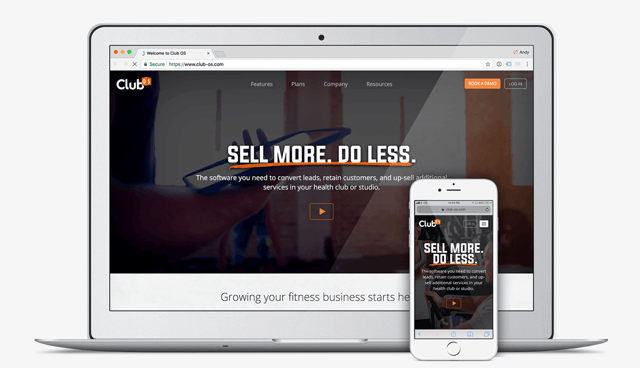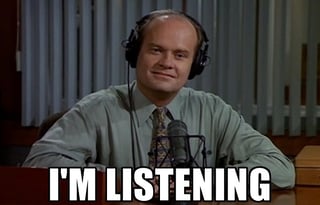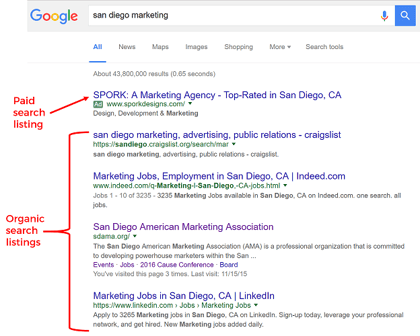
There are two main types of visitors checking out your gym's website: current members and prospects. Yes, you may have the occasional random visitor, but the people your website was made for fall into one of those two groups.
So, once visitors are on your website, how do you get them to stay on it and, more importantly, sign up for your gym and purchase services? In this article, we'll go over some tips for how to create content for your fitness website that generates leads and engages members.
1. Think about user intent.
You may want to share every single thing you can think of with your prospects and members, but that doesn't mean they want to read it. Don’t overwhelm visitors with information that they don’t necessarily need. Let's consider why each type of visitor will decide to visit your website—i.e., their user intent.

Current Member Intent
There are a few reasons current members will want to visit your gym website.will probably want a way to log into their account to make profile changes such as payment methods, reschedule personal training sessions, or classes. If you don’t have any type of online self-service capabilities, you may want to consider changing that, especially if you have a younger clientele who is telephone-averse.
They may also be interested in what’s going on at your business. This presents opportunities to inform them of upcoming events, new merchandise, referral programs, etc. Anything that can inspire and make them feel like a part of the family. This will in turn help with overall retention. Just be careful not to talk too much about your business. Give them content that they can actually use. For example, you might hire a nutritionist (or someone on staff) to write a blog on eating healthy during winter when all we want is pizza. There are even more examples on how to increase retention by engaging with existing members here on our blog called, "Three member-centric business growth techniques for gyms."
Prospects: Why would someone that’s not a current member or client visit your website? Most likely it’s to learn about what you do, how it can benefit them, and how they can learn more and/or take advantage of an offer.
To take this a step further, if the prospect found your website through an ad or a social media post for a specific offer, you want to ensure you send that person to a page on your website where they can take advantage of that offer right away without having to click or tap anywhere else. Don’t just send them to your homepage where they then have to try to locate the deal on their own. They will probably give up.
2. Put important information above the fold. (Usually focused on prospects.)
“Above the fold” comes from printed newspapers where the most important information needed to be placed above where the paper was folded and therefore hiding the bottom half from view. In web-speak it simply means to keep important information above where the person viewing your page can see without scrolling.
You want to hit them with an offer they can’t resist right from the get-go. The most important part of this is to give them a call to action. Put a button they can click or tap to take advantage of the intro offer, or watch a video, or whatever else you want to inform them of in such a prominent place.

3. What content should your website have?
This can vary wildly depending upon the type of visitor, how they got to your website, and more. But you have to tell them something and you have to give them the ability to take some sort of action. Like I learned while working at a CD store many years ago, if you don’t have the CD in stock and the potential customer says they’ll come back…they aren’t coming back.
Of course, in marketing there are now ways to haunt them after they leave your website thanks to the ability to add cookies to their web browser so that you can "remarket" to them. However, the effectiveness of remarketing is starting to wane thanks to major browsers like Chrome and Safari implementing new privacy rules.
This means you must to capture your visitor’s attention while you’ve got them on your page which brings us back to the necessity of defining visitor intent.

You also have to keep in mind that you’re writing for humans and robots. By robots I’m referring to Google’s web crawler which is what roams the internet night after night for years on end feasting on the content of innocent websites all over the world. Ok, so it doesn’t just do that at night, but it sure makes it sound more dramatic that way.
4. How to write for humans and robots. (Search engine optimization)
More than likely this is already happening naturally on your fitness business website. If you own a gym, you will probably talk about how your business is a gym and not, say, an oyster bar. This ensures that Google’s crawlers know to show your website when people search “gym” in your area. Even still, there are some less-than-obvious, though still organic ways, of ensuring Google’s crawlers know your website is important and relevant, especially to people searching for what you do. You can rest easy knowing that it’ll put your website at the top of the list when people search the internet for your type of business.
How to be at the top of search results using keywords.
If you want to rank highly in Google search results when someone in your area searches “[your city] gym” or “yoga studio,” you need to make sure you’re telling Google’s crawlers, “Hey, over here! We’re an awesome gym/yoga studio in that city! Show our website at the top of the list!” This is otherwise known as SEO (search engine optimization).
 Source: http://sdama.org/knowledge/digital-marketing-glossary-terms/#serp
Source: http://sdama.org/knowledge/digital-marketing-glossary-terms/#serp
The best way to write SEO-friendly copy is to write to your ideal customer while also keeping in mind the keywords you want to target. You may be asking, “how can I find the keywords to use on my website?” Well, this is what I was referring to before when I said that you’re most likely already doing this in some capacity.
There are many ways of optimizing your website for search engines, most of which might be overkill for you depending upon the size of your business, how much competition you have in your area, and how many people are actually searching for businesses like yours. That’s why I like to keep most keyword strategies as simple as possible.
My favorite method, especially if you've never done any search engine optimizing, is to simply type out what a normal human being would type into Google when trying to find a business like yours. Yes, it seems overly simple (because it is), but you’re not running a billion dollar Silicon Valley-based unicorn startup competing with other businesses that also have their own in-house search engine optimization teams. Yes, you may have a lot of competition in your area and yes every little edge you can have over them is great, but that doesn’t mean people on Google are going to be any more clever with their searches than if you were based in a town with a population of 20. You still have to create copy and content that’s relevant to real humans that are making real, organic searches into Google. So, that being said…
If you have a gym in Austin, TX you might type out the following possible searches that real people would make:
- gyms in austin
- gyms in austin texas
- gym austin
- workout austin
- gyms around austin
- health club austin
- new to austin workout
- austin fitness
Note: It’s becoming more common for people to leave out the city name when they search for something. We searchers simply expect Google to know where we are and that we’re looking for “gym” near where we’re performing the search. In that case, you’d want to ensure your “Google My Business” information exists and is up to date. Go here to sign up or make edits to your Google My business info. Another tip for this type of “lazy” search, which is also great for SEO, is to ensure your business address is on every page of your website, even if just in the footer. If you have a lot of locations then you will need a more advanced strategy as you can’t fit them all on every page.
"Ok, but where should I put these keywords?"Now we’re getting to the fun part! Here’s the obvious: Take the keywords you defined using the “what would normal people search for” method and try to use them throughout your website. Don’t force them into places that don’t make sense, and don’t overuse them, but do make sure they’re featured throughout your site.
Ok, glad we covered that, but now we’re going to get a little more serious and into some less obvious SEO tactics.
You want to find the most relevant and highly searched keywords that you wrote out and put them into the page titles of each page of your website. So, for example, if you run a gym you will want to make sure the word “gym” is in the title of your website so that Google knows your website is a gym and that it should be shown when someone searches “gym” in your area. Changing page titles can vary depending upon the website creation software you use, but really it’s just the title of each specific page.
Some pages on websites are automatically titled things like “Homepage” or “Contact” page by the software being used to create the website. You would want to change that to at least include “gym.” So instead of “Homepage” it would be “Homepage - Your Business Name - Gym, Austin, TX” etc. Just google “change website page titles ________” with your software in the blank.
So how do you figure out which of your keyword strings are the most popular for your business and therefore should be featured in your website titles? Google has their own tool for this called "Keyword Planner" that can be a great resource. However, it is made specifically for use alongside Google AdWords. That's not necessarily a bad thing as you will eventually want to try creating some Google ads. (Check out our e-book on online advertising for gyms, fitness businesses, and studios.)
5. Know that there is a lot more you can do (but this blog can only be so long).
Here is where I list out some things you should consider investigating the value of for your website. Most of these can be put in place very quickly and you'll see results hours after implementation. However, it’s always a good idea to plan how will you support any new initiatives (if support is needed) and what the potential benefits are of implementing each new thing. But that’s the great thing about websites, you can constantly make changes to see if those changes improve your desired metrics and if they don’t then you can put everything back as it was.
Online chat - Your website visitors are obviously there for a reason and that reason is typically that they’re looking for information. What if you were right there to give it to them and answer any questions keyboard to keyboard? Chat is different depending upon if the visitor is a current member vs. a prospect, but there are also ways to manage that. Let’s say you only want to chat with prospects. Well, chat software depending, you could say “only show chat window to new visitors” which means only people that have never visited your website before (most likely anyone but current members) will see the chat window popup.
Exit popup - These are the windows that we’re all becoming more and more familiar with on the internet. There’s a reason for that: they work. However, they only really work if they make an offer the viewer can’t refuse. What incentive are you going to give people to make them hand over their email address or even credit card? You can even get clever with exit popups and only show them on specific pages of your website as visitors “qualify” themselves. Let’s say a new visitor goes to your homepage then clicks on your pricing or intro offer page then goes to close their browser window. When they make that move, you could automatically show an exit popup that makes an even better offer than what they see on your pricing or intro offer page.
(More) SEO optimization - It’s more than just keywords. There are all types of things you can do to improve your website’s SEO. A great place to start is by entering in your URL in a free tool that scans your website and tells you what to fix like https://www.seoptimer.com or https://seositecheckup.com. Additionally, if you’re using WordPress, I would encourage you to download a plugin called “Yoast” which will act as an “SEO sidekick” for your website.